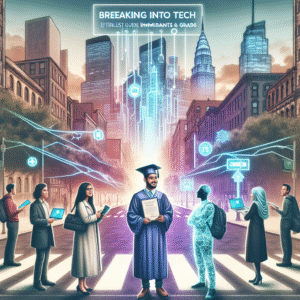Breaking Into Tech: Effortless Guide for Immigrants & Grads
Breaking into tech isn’t just for Silicon Valley insiders or coding prodigies — it’s a real possibility for immigrants and recent graduates ready to start a career that’s globally in demand, financially rewarding, and flexible enough for remote work. Whether you’re switching industries or just starting out, the tech world is far more accessible than it seems, especially with the rise of online learning, freelancing platforms, and the remote work revolution.
If you’re based in Tier 1 countries like the US, Canada, the UK, Australia, or New Zealand — or you’ve recently landed there as an immigrant — the opportunities to enter and grow in tech are unprecedented. This guide is designed to walk you through the essentials, including practical steps, smart strategies, and insider tips to help you break into tech without spending years (or a fortune).
—
Why Tech Is the Smartest Career Move in 2025
Tech careers are no longer limited to hardcore programming jobs at big-name companies. In 2025, tech is everywhere. From SaaS startups and eCommerce platforms to AI tools and digital marketing, nearly every business relies on technology — and they need people who can build, manage, and scale those tools.
A few reasons why tech is a top career choice today:
– Remote-friendly: Most tech roles are fully remote or hybrid, offering flexibility and location independence.
– Well-paying, even at entry level: Junior UX designers, data analysts, or support engineers regularly earn $60,000–$90,000+ annually.
– Skills-first hiring trend: Companies are hiring based on portfolios, certifications, and practical knowledge — not just degrees.
– Fast growth: Learning the right skills can land you a job in under a year.
—
The Best Tech Roles for Immigrants and Grads Without Experience
You don’t need a computer science degree to work in tech. There are plenty of roles suited for beginners, career switchers, or those entering the workforce for the first time.
Beginner-friendly roles to explore:
– Web Developer: Learn HTML, CSS, JavaScript — and build websites for clients, startups, or even yourself.
– Product Manager: Ideal for those with organizational skills and business sense — no coding required.
– UX/UI Designer: For creatives with an eye for detail. Learn design tools like Figma and Adobe XD.
– Data Analyst: Combine Excel, SQL, and a bit of Python to help companies make smarter decisions.
– Tech Support/Helpdesk: Get your foot in the door while learning the company’s systems and tech stack.
💡 Tip: Start by identifying your existing strengths (language skills, sales experience, creativity, problem-solving) and match them to suitable roles in tech.
—
Upskill Fast: Affordable Ways to Learn Tech Skills
Certification and practical knowledge now outweigh traditional degrees. You can get job-ready in 3–6 months with consistent effort — often for less than the cost of a semester at university.
Top learning platforms that won’t break the bank:
– freeCodeCamp.org – Beginner-friendly coding bootcamps with certificates (100% free).
– Coursera or edX – University-backed courses in project management, data science, AI, and more.
– LinkedIn Learning – Great for professional branding plus software-specific tutorials.
– Google Career Certificates – Industry-backed certifications in fields like IT support, UX design, data analytics.
Learning tips for immigrants and new grads:
– Make a study schedule that fits around your current job or family responsibilities.
– Apply what you learn by building mini-projects or helping nonprofits and local businesses.
– Don’t just collect certificates — build a portfolio that proves your skills.
—
Build Credibility with Freelance Work and Internships
Breaking into tech often starts with smaller gigs that help build up your resume — and your confidence.
Freelancing platforms to find your first tech jobs:
– Upwork: Great for web development, data entry, and design projects.
– Toptal: More advanced, but lucrative once you have experience.
– Fiverr: Ideal for simple gigs you can deliver quickly (design logos, create dashboards, fix bugs).
– Contra and SolidGigs: Platforms tailored for remote tech freelancers.
Internship hacks for immigrants/graduates:
– Cold-email startups or nonprofits offering to help on a project — many will jump at the free assistance.
– Search for “remote internships” on job boards like AngelList, We Work Remotely, and Remote OK.
– Collaborate with others from bootcamps or online courses on open-source projects.
—
Personal Branding: Your Shortcut to Getting Noticed
In a competitive market, your digital presence can do the pre-selling for you — especially if you don’t have years of experience.
How to boost your online profile:
– LinkedIn: Optimize your profile with keywords like “Junior Front-End Developer” or “Aspiring UX Designer.” Share learning milestones, builds, and success stories.
– GitHub: Upload coding projects and document what you’ve built. Recruiters value this more than resumes.
– Portfolio website: Buy a domain (yourname.com), showcase your projects, and write short blog posts about what you’re learning.
– Twitter/X and Medium: Share your insights and experiences — tech hiring managers often scout through these channels.
—
Breaking into Tech: Roadmap for Immigrants & Grads
Let’s simplify this process into a step-by-step plan you can act on today.
1. Choose your tech path. Research roles that fit your interests and skills.
2. Start learning. Pick one platform, study 5–10 hours/week, and stick to it for 3–6 months.
3. Build as you learn. Create real or imitation projects to showcase your skills.
4. Create a killer LinkedIn and GitHub profile. Your future employers will Google you.
5. Apply weekly to jobs (startups, remote roles, or internships). Don’t wait to feel ‘ready’.
6. Keep upgrading. Learn new tools, network on tech forums, apply for certifications.
7. Stay consistent. Even if progress feels slow, results compound with time.
—
Final Thoughts: Your Background Is an Asset, Not a Barrier
Being an immigrant or fresh graduate is often perceived as a disadvantage. But in the tech world, diversity, fresh perspectives, and resilience are superpowers. Many companies are actively recruiting globally — as long as you can deliver and communicate well, your location or accent won’t stop you.
You don’t need to be a coding wizard or have a fancy diploma to break into tech. You need direction, consistency, and a willingness to learn and adapt. With the rise of remote work, freelancing platforms, and skills-based hiring, this is one of the most inclusive industries today.
So build. Apply. Persist. Your tech career doesn’t have to be perfect — it just has to begin.
—
Ready to kickstart your journey?
Pick one role, find a free course, and build your first project this (Incomplete: max_output_tokens)



7 thoughts on “Breaking Into Tech: Effortless Guide for Immigrants & Grads”